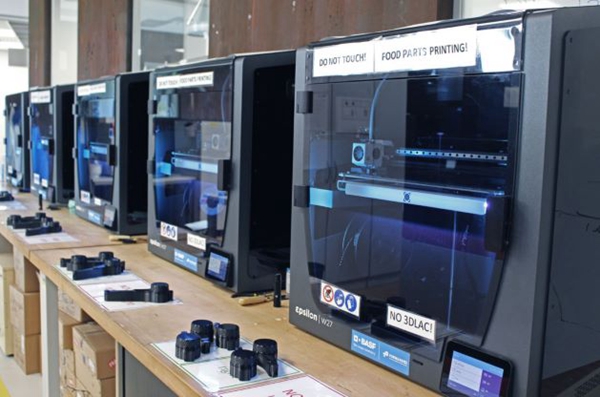3DPrinting is becoming a widely used manufacturing technology, not only for prototypes but also for small and medium series. Sorted3DIndustry and use of printing3DSix trends that are having a major impact on print technology professionals. Let’s explore together3DWhere is the future of printing?

1.A new era: bigger, faster, more economical
3DPrint/Additive manufacturing(AM)Technology is evolving rapidly, they are becoming bigger, faster and more economical. In order to meet the required performance requirements of the final components, currently3DThe printing industry’s growing demand for specialty materials will continue to determine the range and types of materials used. The key to the new generation of printers, especially industrial-grade solutions, is their ability to process a wider range of advanced materials, opening the door for businesses to start fromAMis poised to benefit, and while machine costs remain high, improving print speeds are driving down part prices. As more and more businesses turn to3DThe impression, I think the cost will become lower and lower. With the development of processes such as double extrusion,3DThe versatility of printing is increasing and we are seeing increasing industry adoption.3DPrint. Another trend is to print without using support structures, which, again, extendsAMWith the range of applications it can offer, the potential for supportless printing to save time and money is enormous.
2.Improve efficiency and interoperability
AMTo maximize the benefits of a holistic supply chain approach, manufacturers not only need a large number of printers, but also materials and connections with other industry professionals. in order to maximize3DWith the potential of printing, interoperability between different systems is becoming increasingly important. Automation and complete availability of production and post-processing will remain an important trend in the coming years.AMA new supply chain approach can be proposed, in which individual steps must be integrated into a process, including design, materials, digital inventory, production and delivery. As manufacturers move toward industrial4.0Era, providing fully automated and secure platforms will drive this change.
3.Develop common standards and synergies
From individual partnerships to complete work systems, greater collaboration creates mutual benefits and synergies that lead to better products for the end customer. want to enlarge3DThe main driver of industrial production in printing is collaboration. More and more manufacturers are seeing the need for more global collaboration.3DThe printing community must work together to develop standards, printers and post-processing systems must be able to work together, and the production data collected can improve printers and materials. Close collaboration is essential to achieve the best solution. There is an urgent need to establish a system connecting global service providers, material manufacturers and printer manufacturers. We must know that only through close cooperation and constant communication can manufacturers provide the best solutions to customers.
4.Safety and quality assurance
For industrial production, companies must ensure that their3DThe printed parts meet the necessary quality requirements. Additionally, data ownership plays an important role and data management will be a major priority in the future. When it comes to quality assurance, production partners must be carefully selected to review their capabilities and ensure parts are reproducible and fit for purpose. Of course, this is far from enough and additional steps need to be taken to ensure that design data is in the hands of the business. The company encrypts data to set manufacturing parameters that can be run, so parts can only be produced in the quantities and materials required. By collecting and analyzing manufacturing data, errors can be quickly discovered, processes can be improved and all quality requirements can be guaranteed.
5.Create a resilient supply chain
Issues such as COVID-19 and cross-border trade disputes have demonstrated the fragility of supply chains.3DPrinting has been used to solve these problems in the past, and its use will continue to grow. With the decentralization of supply chains and on-demand production close to where consumers are,3DPrinting makes supply chains shorter, stronger and more resilient. Physical inventory is the weak link in any supply chain, and parts can be stored digitally rather than in physical warehouses, eliminating storage and shipping costs. With a digital warehouse, once a part is ordered, it can be automatically sent to the most appropriate and suitable production partner based on location, capacity and capacity. Parts can be produced anywhere and at any time and increase supply chain resilience.
6.Promoting sustainable development
3DCan reduce waste in the production process. Specially designed for3DPrinted parts can significantly reduce the weight of the final part, reducing the material needed for production. Additionally, as mentioned earlier, when using3DWhen printing is part of a decentralized, on-demand digital warehouse, it can reduce the number of parts and associated waste in inventory, as well as during shipping.CO₂Emissions. Looking to the future, it is expected that3DPrinting will be increasingly used as part of the company’s sustainability strategy. To further increase the sustainability of the technology, energy consumption in the production process must be reduced, and we are already seeing huge improvements in this area. Additionally, we will see sustainable solutions3DThere are a growing number of printing materials such as recycled, reusable and biodegradable plastics.
Source: 3D Printing Network
Daguang focuses on providing solutions such as precision CNC machining services (3-axis, 4-axis, 5-axis machining), CNC milling, 3D printing and rapid prototyping services.

















